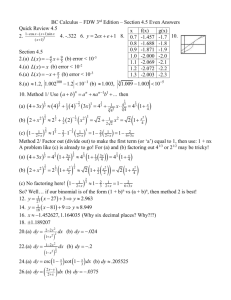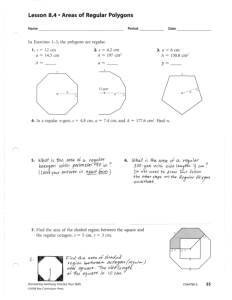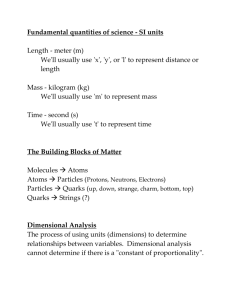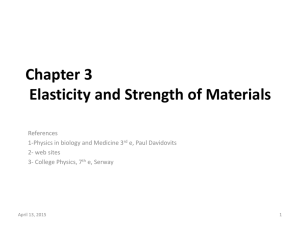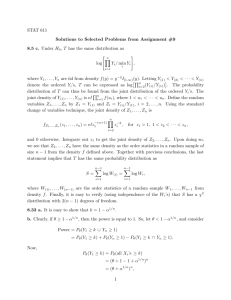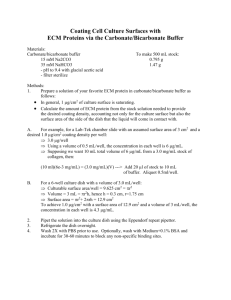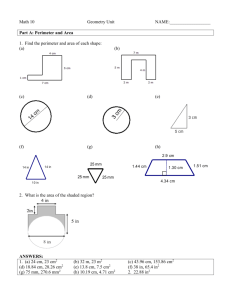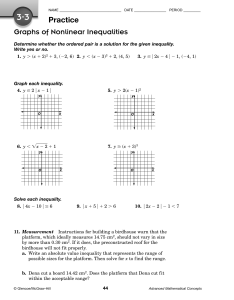Sinai University Subject: Electrical Materials (ELE163)
advertisement
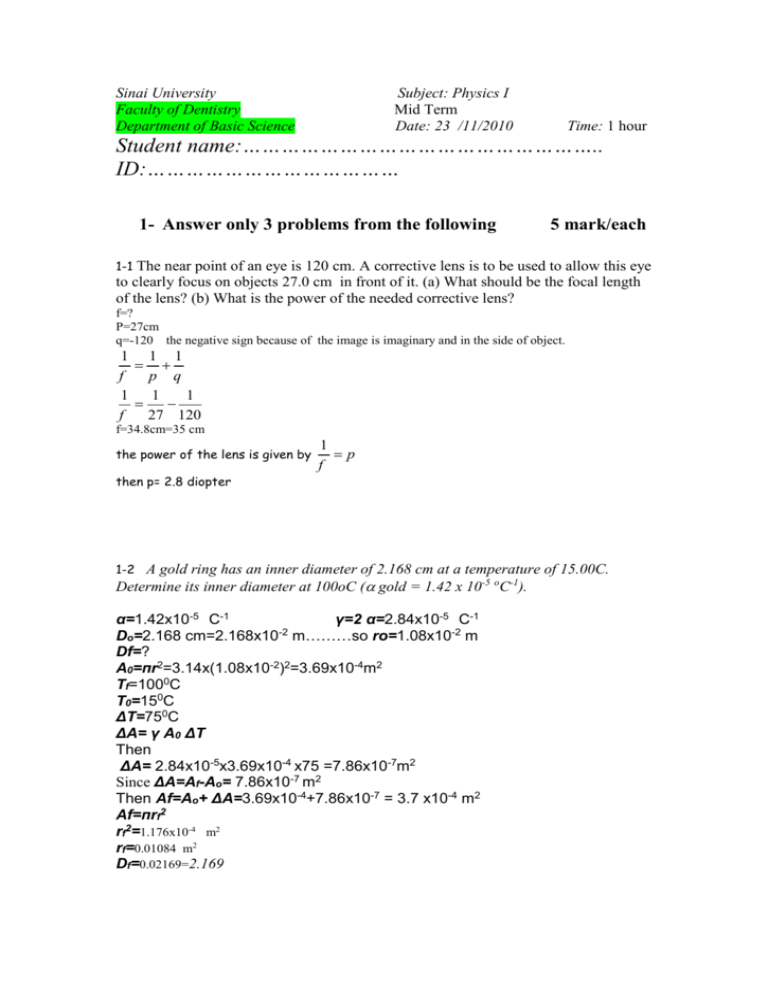
Sinai University Faculty of Dentistry Department of Basic Science Subject: Physics I Mid Term Date: 23 /11/2010 Time: 1 hour Student name:……………………………………………….. ID:………………………………… 1- Answer only 3 problems from the following 5 mark/each 1-1 The near point of an eye is 120 cm. A corrective lens is to be used to allow this eye to clearly focus on objects 27.0 cm in front of it. (a) What should be the focal length of the lens? (b) What is the power of the needed corrective lens? f=? P=27cm q=-120 the negative sign because of the image is imaginary and in the side of object. 1 1 1 f p q 1 1 1 f 27 120 f=34.8cm=35 cm the power of the lens is given by 1 p f then p= 2.8 diopter 1-2 A gold ring has an inner diameter of 2.168 cm at a temperature of 15.00C. Determine its inner diameter at 100oC ( gold = 1.42 x 10-5 oC-1). α=1.42x10-5 C-1 γ=2 α=2.84x10-5 C-1 -2 Do=2.168 cm=2.168x10 m………so ro=1.08x10-2 m Df=? A0=пr2=3.14x(1.08x10-2)2=3.69x10-4m2 Tf=1000C T0=150C ΔT=750C ΔA= γ A0 ΔT Then ΔA= 2.84x10-5x3.69x10-4 x75 =7.86x10-7m2 Since ΔA=Af-Ao= 7.86x10-7 m2 Then Af=Ao+ ΔA=3.69x10-4+7.86x10-7 = 3.7 x10-4 m2 Af=пrf2 rf2=1.176x10-4 m2 rf=0.01084 m2 Df=0.02169=2.169 1-3 Assume that a 50-kg runner trips and falls on his extended hand. If the bones of one arm absorb all the kinetic energy (neglecting the energy of the fall), what is the minimum speed of the runner that will cause a fracture of the arm bone? Assume that the length of arm is 1 m and that the area of the bone is 4 cm2.(SB=100x107 dyn/cm2) (Y=14x1010 dyn/cm2 ) m=50 kg=5x104g v=? Lo=1 m=100 cm A=4 cm2 SB=100x107 dyn/cm2 Y=14x1010 dyn/cm2 The kinetic energy =The energy required to cause a fracture of the arm 1 1 YA S L mv 2 ( )( B o ) 2 2 2 Lo Y 14x1010 x4 100x107 x 100 2 5x 10 v ( )( ) 100 14x1010 4 2 14x1010 x4 100x107 x 100 2 v2 ( )( ) 100x 5x 104 14x1010 v2=5.71x104 cm2/sec v=239 cm/sec=2.39 m/sec 1-4 From what height can a 1-kg falling object cause fracture of the skull? Assume that the object is hard, that the area of contact with the skull is 1 cm2, and that the duration of impact is 10−3 sec. .(SB=100x107 dyn/cm2) (Y=14x1010 dyn/cm2 ). h=? m=1kg= 103g A=1cm2 Δt=10-3 sec SB=100x107 dyn/cm2 Y=14x1010 dyn/cm2 g=9.8 m/sec2=980 cm/sec2 Since the object move because of the acceleration due to gravity ,so the impulsive force is given by F m 2 gh t Since F F SB A=100x107 x1=109 dyn A 103 9 10 3 2x 980h 10 6 10 1960h h =510 cm =5.1 m SB = 2-Circle the correct answer the following MCQ (10 marks) 2-1 1. Which one of the following temperatures is approximately equal to "room temperature?" (a) 0 K (c) 100 °C (e) 293 K (b) 0 °C (d) 100 K 2-2 Heat is added to a substance, but its temperature does not rise. Which one of the following statements provides the best explanation for this observation? (a) The substance must be a gas. (b) The substance must be a non-perfect solid. (c) The substance undergoes a change of phase. (d) The substance has unusual thermal properties. (e) The substance must be cooler than its environment. 2- 3 If two objects are in thermal equilibrium with each other: A. they cannot be moving B. they cannot be undergoing an elastic collision C. they cannot have different pressures D. they cannot be at different temperatures E. they cannot be falling in Earth’s gravitational field 2-4 Suppose object C is in thermal equilibrium with object A and with object B. The zeroth law of thermodynamics states: A. that C will always be in thermal equilibrium with both A and B B. that C must transfer energy to both A and B C. that A is in thermal equilibrium with B D. that A cannot be in thermal equilibrium with B E. nothing about the relationship between A and B 2-5 In constructing a thermometer it is NECESSARY to use a substance that: A. expands with rising temperature B. expands linearly with rising temperature C. will not freeze D. will not boil E. undergoes some change when heated or cooled 2 -6 The specific heat of a substance is: A. the amount of heat energy to change the state of one gram of the substance B. the amount of heat energy per unit mass emitted by oxidizing the substance C. the amount of heat energy per unit mass to raise the substance from its freezing to its boiling point D. the amount of heat energy per unit mass to raise the temperature of the substance by 1◦ C E. the temperature of the object divided by its mass 2-7 A beam of light passes from air into water. Which is necessarily true? (a) The frequency is unchanged and the wavelength increases. (b) The frequency is unchanged and the wavelength decreases. (c) The wavelength is unchanged and the frequency decreases. (d) Both the wavelength and frequency increase. (e) Both the wavelength and frequency decrease 2-8 Complete the following statement: Fiber optics make use of (a) total internal reflection. (c) chromatic aberration. (e) dispersion. (b) polarization. (d) Brewster's angle. 2-9 In the reflection of light flat and smooth surface: a. the angle of incidence equal the angle of reflection b the angle of incidence is larger than the angle of reflection c the angle of incidence is smaller than the angle of reflection d. none of the above 2-10 The purpose of prescription glasses for a near-sighted person is to bring far objects a. to the far point of the eye c. to the retina of the eye b. to the near point of the eye d. none of the above
